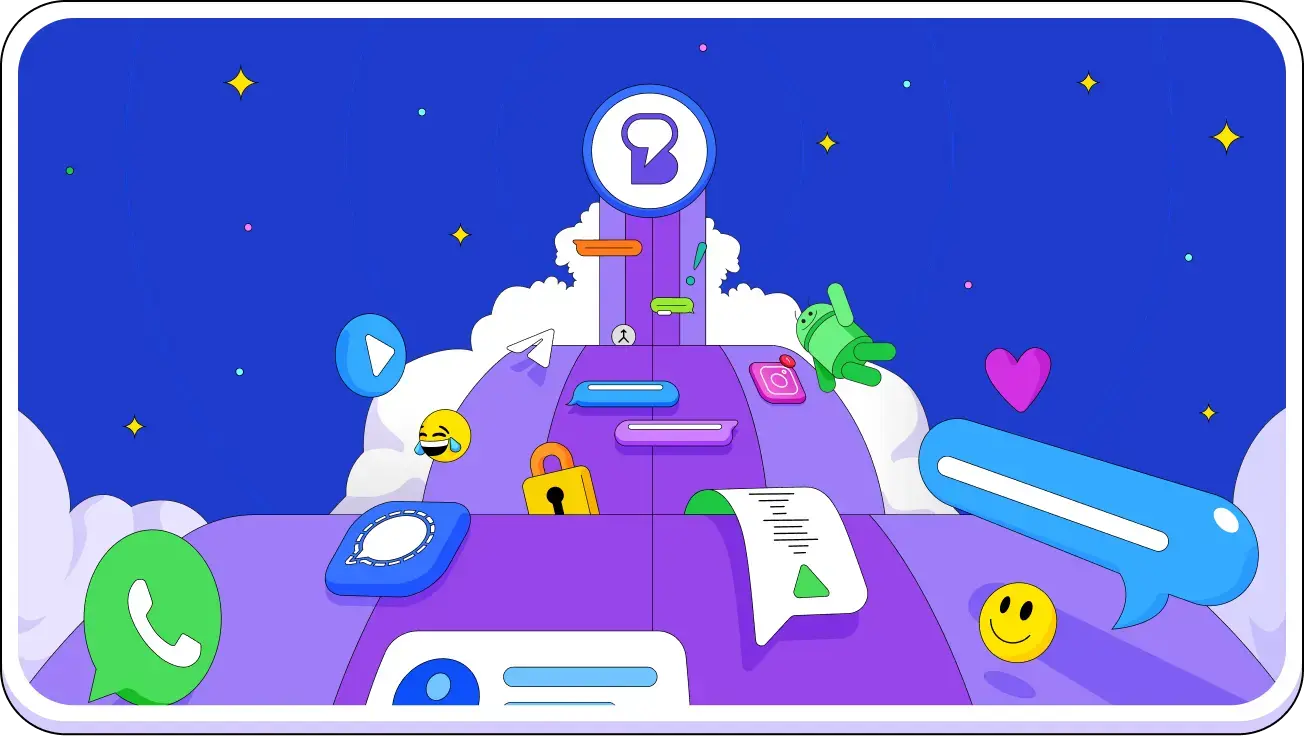There’s a lot of FUD in this comments section, so I’d like to clear the air. I’m pretty big on OSS myself, so it pains me to see a company doing all the right things get lambasted like this.
Beeper is just a Matrix server running in tandem with a series of custom, open source bridges written by Beeper. The value proposition is not having to deploy a Matrix server yourself, and not having to deploy each bridge yourself.
However, if you want to do that you absolutely can. I’ve been running Synapse + a subset of their bridges for a couple years now (the WhatsApp one being the oldest), and they are fantastic.
The devs contribute back to Matrix all the time and are great about supporting the spec as a responsible third party.
Their only closed source software is their client, which is - by definition - only written to work with their servers and not generic Matrix servers (e.g. It’s just a preconfigured matrix client which expects each bridge to be deployed, and doesn’t ask you for things like what server you want). As a result, you wouldn’t want to use it with your own stack; you can just pick one of the myriad OSS clients available for Matrix and go with that. I use SchildiChat, for example.
I don’t understand why, after doing all this work and publishing the source online for free (free as in freedom), they aren’t allowed to offer a preconfigured service to non tech savvy folk?
Honest question: Shouldn’t they be paid for their work?
Edit: And, please, stop asking questions like “How do they connect to X/Y/Z, anyway?” - just go read the source and see for yourself. These are the good guys working completely in the open, and you’re treating them as if Twitter just wrote a chat app.
Not sure there is much FUD, let me see if I can sum up the points:
- Beeper devs have written a bunch of bridges between Matrix and other services. ✅ Cool
- They’ve contributed to Matrix. ✅ Cool
- End-to-end encryption, ends at each bridge server, which needs to decrypt and re-encrypt every message (¹). ❌ Not cool
- They’re OpenSource, so anyone can self-host their own bridge. ✅ That’s cool… but contrary to the “value proposition” of not having to do so 🤷
- Encryption in anything closed source, like their client, is ❌ not cool… but you can use a different client, so 🤷
- Decryption on not-selfhosted servers, is ❌ not cool… but you can self-host them, so 🤷
- All clients come “preconfigured” for some service 🤷, but theirs is locked to a service. ❌ Not cool
- People using a client with E2EE, get that expectation broken by Beeper (client) users giving their keys to a bridge hosted by a 3rd party. ❌ Not cool
- FUD: The devs’ monetization strategy isn’t clear. (“premium features” in the client? 🧐)
TL;DR: Sounds like a reasonable way to move unencrypted messages around… but falls short of fixing the problem of having secure interoperable E2EE.
Should they get paid for it? Probably, if you find that useful.
(¹: if there is any bridge capable of forwarding encrypted messages without decrypting, please correct me)
The not cool parts just relate to any sort of hosted bridge. If you don’t trust them with decrypting messages on their end, then don’t give them your data - there are no bridges capable of doing that, anywhere.
So it really comes down to “trust someone else with your data, or host it yourself”; and if you’re - understandably - frustrated with those options blame companies like WhatsApp or Discord that make it nigh impossible to integrate their services with outside networks.
Functionally, these bridges just forward your content to a library acting like a headless client - there’s no way to encrypt that as the reverse engineered clients are not libraries and need to take raw input. You can’t end to end encrypt it as the client is one of the “ends”.
As an example, the WhatsApp bridge uses WhatsApp web as a backend, and has all the limitations of WA web.
As a result, I find the expectations to be a bit unrealistic.
Does the whole encryption/decryption thing still bother you if you self host?
I tried out the app, the value there is that it’s ready to go straight away, though I took it all down again because my messages being unencrypted on someone else’s server makes me uneasy. May end up self hosting it for that reason and not using anything closed source
Somewhat. It’s kind of a gradation:
- 3rd party servers, or closed source, no trust.
- Self-hosting on a hosting provider… it’s not my hardware, but maybe some trust.
- OpenSource with non-reproducible builds, even self-hosted at home, little trust.
- Local bridges, OpenSource, with reproducible builds, and a 3rd party audit, most trust.
All software can have bugs, and we’ve seen what cases like xz-util can bring, so I would rather have no decrypting bridges at all, particularly for sensitive information… but for random private chats, “mostly trusted” sounds like enough.
Public conversations (like this one) are fine going through random bridges, but I feel like bridging with E2EE networks, is subverting user expectations.
All of that needed to be said. Thank you.
Seems like they did good until now. I’m not confident, even skeptical, that will keep going after the acquisition though.
Gravatar was a great, independent, minimal service. Now it’s a horrendous, bloated service.
I hope they continue to do good, but am also skeptical.
And, man, I miss the old Gravatar.
deleted by creator
Honestly I understand where you’re coming from but I’m going to be a bit pragmatic, it’s free, it centralizes all my shit chat apps into one “shit app” (the app is excellent so far) I won’t bridge it to signal because that would be my safe app but for insta, messenger, Discord, telegram and even SMS/RCS I have no issues
deleted by creator
Love the CEO sketches! And they’re not even in the top five things Brennan has done, probably!
Wow! That’s one annoying video!
Bought by Automattic? After they non-consensually took all of Tumblr and hosted Wordpress to train AI? And after their big boss revealed his transphobia? I guess i’ll skip this one
Gravatar was a great, minimal, independent service. Until they acquired it and integrated it into their WordPress platform and onboarding (trying to get you to become a customer).
Dammit yes! Mandatory shot out to David Revoy and his replacements of it (and the blog post where he mentions how he divested himself of CDNs).
You link to an avatar generator.
What made Gravatar great beyond that was that you set it up with your email account, and other websites would use your chosen avatar,identified by email address.
Had a longer answer that went away for some reason 😭
Your criticism is fair, but:
- Using the email as a seed on the generator goes halfway there, here’s an example, although of course it could never change
- Centralizing the avatar opens that service up to be grabbed for tracking like Gravatar did, or breaking the security of a site by injecting code without the consent of the site owner. The usual tradeoff between security/privacy and convenience.
Would be good to have a good user-managed way to do the same (well, beyond using an image on your own hosting, i guess)
Be so nice to notify your contacts about breaking e2ee then, will ya
The Android version has a local bridge that does not break ee2e for Signal. It is an experimental option, but it was easy to turn on and use
It’s nice that the option exists, I didn’t know that. But I have to say, I’m still not a fan of the overall concept of bridges
That seems really exciting! But don’t services like Discord forbid third party clients?
But don’t services like Discord forbid third party clients?
Me waiting for inflation to slowly increase Discord’s yearly revenue until it tips into the legally defined Gatekeeper™ status under the EU Digital Markets Act so they’d be playing with fire if they banned people for using interoperability apps.
I’ve been using Beeper with a Discord bridge for three years now. No problems.
Beeper isn’t a Discord client.
Kind of is though, if it quacks like a duck
My arse quacks like a duck
deleted by creator
deleted by creator
deleted by creator
Discord’s own Linux client is kinda ass and keeps breaking my build using old insecure electron versions/forcing you to update before you can use the app while not being up to date in my package manager
Gotta use a custom client anyway to keep my sanity intact
deleted by creator
I’ve been using a Discord bridge with Beeper for three years with no problems.
deleted by creator
deleted by creator
You were asking how it interacts with Discord. That is the code.
Beyond that it’s running a version of Synapse and has its own client - the latter being optional.
you can use any opensource matrix client with your beeper account
Another closed source chat app? Yeah, no thanks.
Anti Commercial AI thingy
Not closed source. It’s just a Matrix server instance running their own bridges. All the backend stuff is open source, the only closed source part is their client.
The client is specific to their site and unnecessary: just deploy Synapse, then pick and deploy the bridges of their suite you want to your server. You can then pick and use any of the available Matrix clients to get the same exact features. You can even sponsor them on Github, as I’ve been doing for months.
the only closed source part is their client.
Which is exactly what I’m referring to. Plus, they can say they run a matrix server, but if your frontend is closed source, there’s no way I trust that they actually do run a fully opensource backend. Wouldn’t surprise me one bit to hear/read that they have closed source components in the backend too. Big nope from me.
Anti Commercial AI thingy
You can use any Matrix client with Beeper, you don’t have to use theirs.
Regardless, there’s nothing stopping you from recreating the same stack using the available tools.
What makes their service unique are the bridges. Download their sources, compile them, and then pair them with any server client combo you want.
If you insist on using their stack, you can still use an OSS client. They chose not to make their client open source as it is, by design, for their service only.
They’re trying to run a business aimed at people who don’t care about open source, and want the same closed source experience they get from their other chat apps but with inter connectivity between third party services.
If you want the latter without any closed source code, you can just go and do that. They’ve released all the important parts.
Edit: Here’s a guide to self hosting beeper.
What is this “closed source experience” you are talking about? How would making the client open source hinder that in any way, especially when their stated goal is to earn money with premium features instead of the app itself?!
Imo being open source is a VERY big deal for an e2e encrypted chat client! I don’t really care whether most of their stack is open if the app I’m actually using to type and encrypt my messages is not. This makes the whole thing look like a trick, pretending to be open when key parts are not.
What is this “closed source experience”
I can answer that: it’s the “I don’t care about security as long as I can send memes and inappropriate messages to most people” experience.
From the looks of it, it’s as secure as having WhatsApp/Signal/Telegram/ProtonMail doing “E2EE” through each app’s servers, and never knowing whether the client did the encryption right, or if it sent the keys to the server for messages to get intercepted… well, except you do know that the bridges are decrypting all messages anyway.
I can answer that: it’s the “I don’t care about security as long as I can send memes and inappropriate messages to most people” experience.
Closed source doesn’t help with that though, you don’t have to care about privacy in open source.
except you do know that the bridges are decrypting all messages anyway
They are working on on-device bridges that preserve e2ee, but making the client closed source kind of defeats the purpose here.
Closed source helps with the second part, the connecting with a majority of people using the same closed source platform (then different people use different platforms, which is where we are now… but the DMA might solve that).
On-device bridges could be nice if they included that in the OpenSource part.
Just use any open source client. You can literally do that.
And if you don’t trust the company - for any reason - use their code to deploy your own backend.
That’s not the point. An app doesn’t become good because you can just not use it.
I disagree. Beeper’s client is meaningless, it’s the service being offered that has value.
If you don’t mind trusting a third party service with your Matrix instance + bridge hosting, use Beeper.
If you’re into OSS and owning your own tech stack, self host the whole thing.
At no point do you have to use their client for any reason.
Given it’s all entirely self host able if you use a different client I’m not sure how they could be
Unless there’s some binary blobs hidden in the repo but you’d think someone would have pointed that out by now
Alright, I got to ask. Having one app for all these services sounds great. I remember some drama around it though, don’t recall the details. So what am I missing, is this actually good news?
Its not open source but neither are most of the apps it connects to.
Edit: Found a comment in another thread that sums up valid concerns https://feddit.nl/comment/8763492
See this comment by @derin@lemmy.beru.co
thanks but I don’t need this proprietary shit
It’s not proprietary, lol. You can download and deploy each of their bridges yourself to your own servers.
Source: been using their WhatsApp, Discord, and Signal bridges for over a year. I use Github sponsors to pay for development, as I appreciate how great they are.
The only closed source part of their stack is their client, which you don’t have to use.
Also, they’re some of the most prolific contributors to Matrix outside of Element. The emoji picker in Element was literally PR’ed by Tulir.
Love it when folk see people trying to make money off OSS and immediately resort to hysterics. It really makes closed source development look appealing if you’re going to be damned by idealogues regardless of whether you release the source or not.
I guess I can finally use proper WhatsApp web on iPad 😂
- Discord? Not working (probably because of TOTP)
- Facebook Messenger? Not working (probably because I use it without Facebook account)
- SMS/RCS? Not working (looks like it requires Google account)
Seems like it’s not ready yet
Obligatory https://xkcd.com/927/
This is not applicable here, since Beeper is “just” Matrix + Bridges + Simplified UX!
Indeed. More like talking 14 competing standards and shoving them under one gui… and I’m here for it. I miss the days of trillian and gaim.
I was a Trillian user as well.
I wish there was an web app.
There is, they just don’t publicise it. Actually one of my favourite features of the service tbf. Just load up a web page and all my messages are there, regardless of where they came from.
Link is incorrect.
Thanks, fixed! (TIL you need the https:// bit on Lemmy)
Sadly doesn’t appear to be usable for SMS by Google Fi users who have web sync enabled. Guess I’ll be holding off.
Without iMessage, right?
Some self-hosters have been able to get iMessage working.





















